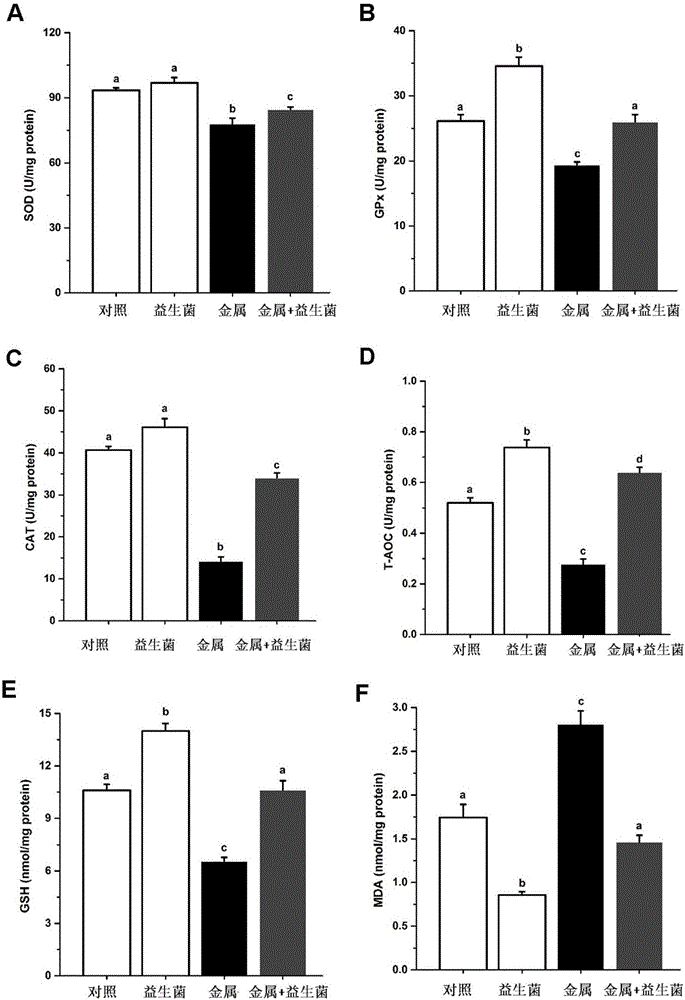Probiotics feed capable of relieving aluminium toxicity of tilapia and application thereof
A technology of probiotics and tilapia, applied in the field of microorganisms, can solve the problems of aquatic bio-aluminum toxicity that have not been reported, and achieve the effect of improving meat quality safety, wide application prospects, and improving intestinal micro-ecological environment
- Summary
- Abstract
- Description
- Claims
- Application Information
AI Technical Summary
Problems solved by technology
Method used
Image
Examples
Embodiment 1
[0034] Prepare feed ingredients according to the basic formula shown in Table 1 and the nutritional composition, and the specific steps are as follows:
[0035] (1) Inoculate Lactobacillus plantarum CGMCC No.9664 into MRS medium with an inoculum size of 2-4% by volume, cultivate at 37°C for 18 hours, wash with pH7.2 phosphate buffer for 2-4 times, and use physiological Resuspend in saline to make the concentration of viable bacteria ≥ 10 11 CFU / mL.
[0036] (2) Prepare premixed feed according to the formula in Table 1, specifically by mass percentage: fish meal 10%, secondary meal 25%, cornstarch 20.5%, soybean oil 6.0%, soybean meal 20%, casein 9.6%, gelatin 2.4% , compound vitamin 1%, compound mineral salt 1%, choline chloride 0.5%, VC sodium phosphate 0.2%, calcium dihydrogen phosphate 1.5, microcrystalline cellulose 2.3%;
[0037] Among them, the multivitamin (mg / kg feed) contains: vitamin A, 10; vitamin D, 0,05; vitamin E, 400; vitamin K, 40; vitamin B 1 , 50; Vitamin ...
Embodiment 2
[0042] Example 2 Effects of Lactobacillus plantarum CGMCC No.9664 on growth indicators of aluminum-exposed tilapia
[0043] A total of 192 healthy Nile tilapias were selected, with an initial body weight of 34.01±0.19g (mean±standard deviation). They were randomly divided into four groups, namely the control group, the probiotic group, the metal group and the metal + probiotic group, with 48 animals in each group, and randomly divided into three parallel groups, each with 16 animals. Control group: fed basal diet (that is, basal feed without probiotic ingredients formulated according to Table 1); probiotic group: fed feed containing probiotics (CGMCC No.9664); metal exposure group, fed basal Diets, exposed to metals (2.73mg / L Al 3+ solution) in the water body of the solution; the metal + probiotic (CGMCC No.9664) group was fed with feed containing probiotics and exposed to the water body containing metal aluminum solution. Tilapia were fed twice a day at 3% of the total tila...
Embodiment 3
[0048] Example 3 Effect of Lactobacillus plantarum CGMCC No.9664 on the reduction of aluminum content in aluminum-exposed tilapia
[0049] Carry out animal experiments and grouping with tilapia as described in Example 2, kill the tilapia after the experiment and dissect, take the tissues and organs of each part, put them into a microwave digestion furnace for digestion for 20min, and use the inductive coupling to obtain the digestion solution Aluminum content was determined by plasma mass spectrometry (ICP-MS; NexIon-300X; PerkinElmer). The experimental results are shown in Table 3.
[0050] Table 3 Aluminum content in different parts of tilapia
[0051]
[0052] Note: - means not detected; the unit is μg / g tissue wet weight; groups marked with different letters mean significant difference (P<0.05).
[0053] Comparing the metal + probiotic group with the metal group, it can be found that the probiotics significantly reduced the aluminum content in the gut, liver and splee...
PUM
 Login to View More
Login to View More Abstract
Description
Claims
Application Information
 Login to View More
Login to View More - R&D Engineer
- R&D Manager
- IP Professional
- Industry Leading Data Capabilities
- Powerful AI technology
- Patent DNA Extraction
Browse by: Latest US Patents, China's latest patents, Technical Efficacy Thesaurus, Application Domain, Technology Topic, Popular Technical Reports.
© 2024 PatSnap. All rights reserved.Legal|Privacy policy|Modern Slavery Act Transparency Statement|Sitemap|About US| Contact US: help@patsnap.com










